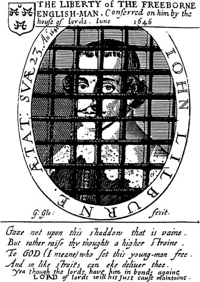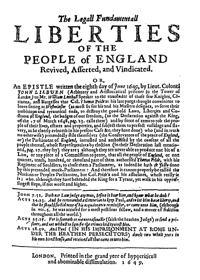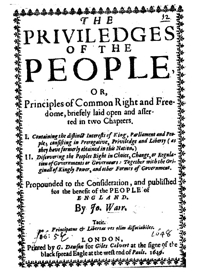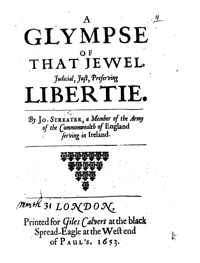


[Andrew Marvell (1621-1678)]




|
The Leveller Tracts and Pamphlets Project
I have some blog posts on this topic:
- “Making and Breaking the Image of King Charles I” (27 May, 2021)
- Thomas Hobbes' Iconography of the Leviathan State (18 December, 2020)
- The Art of the Levellers (27 October, 2020)
- Richard Overton on Tyrants (17 October, 2020)
As well as these texts which I have added recently:
- As part of my Anthology of Leveller Tracts on the forgotten “little people” I have added Thomas Johnson, A Discourse Consisting of Motives for the Enlargement and Freedome Of Trade (11 April, 1645). Although this pamphlet was probably written by an educated merchant or cloth manufacturer I am including it in this anthology because of its defence of the voiceless “little people” who were harmed by the policy of granting a trade monopoly to favourered merchants called the “Merchant-Adventurers”. Johnson includes in this group the following who were impoverished directly by this monopoly: “all owners of Ships, Masters, Mariners, Fishermen, Clothiers, Tuckers, Spinsters, and many thousands of all sorts of Handy-crafts men”, as well as “pettie Shopkeepers and Retailers”. He also mentions those who lost indirectly because of the general decline in prosperity in the country, such as the increasing numbers of “poor men and beggars up and down the land”.
- A more radical, feminist version by Elizabeth Lilburne (or Chidley?) of the 1649 “The Humble Petition of Divers Well-Affected Women” (5 May, 1649), with the opening line “SHEWETH, THat since we are assured of our Creation in the image of God, and of an interest in Christ, equall unto men, as also of a proportionable share in the freedoms of this Common wealth, we cannot but wonder and grieve that we should appear so despicable in your eyes, as to be thought unworthy to Petition, or represent our Grievances to this Honourable House.”
- after receiving an email from a reader about the Leveller tracts I added a couple of "Editor’s Introductions" to explain what the pamphlets are about. I have notes for nearly all 300 in the collection but have not got around to writing them up. See
- William Walwyn’s plea for religious toleration in A Helpe to the right understanding of a Discourse concerning Independency (6 February 1645) see the note
- John Streater's warning to the "slavish" English people about the dangers of power-hungry and corrupt politicians who seek to destroy their "just and equal Freedom" in A Glympse of that Jewel, Judicial, Just, Preserving Libertie (31 March, 1653) - the note
- a chronological list of my selection of key Leveller Tracts 1638-1660 with links to the ones I have online
- while in prison waiting for the verdict and then his death once he had been convicted, Charles Stuart (a.k.a. King Charles I) wrote a defense of his actions and the entire concept of the divine right of kings in a book called Eikon Basilike (The Icon or Image of the King) (1649) [HTML and facs. PDF]. Some of the editions also inlcuded a very detailed iconography of his rule in the form of a frontispiece. John Milton was asked by Parliament to write a rebuttal which turned into a devastating piece of "iconoclasm" aptly called Eikonoklastes (1649) [HTML and facs. PDF]
- to accompany Marvell's book attacking "arbitrary government in England" we now have John Milton's The Tenure of Kings and Magistrates (1649) written just after the execution of King Charles I to defend the actions of the regicides. He argues that individuals have rights which predate the appearance of kings or other "magistrates" and thus, if these kings and magistrates violate those pre-existing rights, the people have the right to remove them. Thus, their "tenure" in this case is quite short. [HTML of a heavily annotated 1911 edition and a facs. PDF of the 1650 ed.]
- Andrew Marvell (1621-1678) was not a Leveller as such but he shared many of their views about the dangers of despotic government in Britain, and was a close friend and work mate of John Milton in the Republican government. I have put online two editions of his collected works (1776 and 1875) in facs. PDF as well as his best known pamphlet on The Growth of Popery and Arbitrary Government in England (1677) in HTML and facs. PDF. The American colonial book seller Thomans Hollis made one of his iconic images of Marvell as a hero of the liberty movement and thus deserving of his laurels. And a selection of some of my favourite poems in HTML.
- Ever since Marcus Junius Brutus (88-42 BC) stabbed Julius Caesar to death in 44 BC, people have been asking is it right to kill a tyrant and, if so, when and by whom. The question was especially important for the Levellers who participated in the trial and execution of King Charles I in 1649 and who also opposed the growing powers of the “Protector” Oliver Cromwell (1599-1658) who replaced him. The radical Leveller “agitator” Edward Sexby (ft. 1642–1667) defended the right of the people to assassinate a tyrant in 1657 in the pamphlet “Killing, no Murder” (in which he had Cromwell in mind). We have put this pamphlet online, along with some other pamphlets by him and his contribution to the Putney Debates in Oct/Nov. 1647 where he defended the rights of the ordinary soliders, as well as two critics of him, an anonymous author and Michael Hawke, both of whom agreed that killing a king, even a bad one, was murder. Here Sexby is very much in the tradition of the French “monarchomach” theorists (from the Greek μόναρχος and μάχομαι, meaning “those who fight against monarchs”) who emerged during the French Wars of Religion in the late 16th century, such as François Hotman (1524–1590), Théodore de Bèze (1519–1605), Simon Goulart (1543–1628), Nicolas Barnaud (1538–1604), Hubert Languet (1518–1581), Philippe de Mornay (1549–1623) and George Buchanan (1506–1582). See:
- some more Leveller pamphlets (29 items), this time by William Walwyn (c.1600-1680), to add to our collection of works by John Lilburne (24 items) and Richard Overton (23)
- more Leveller pamphlets, this time by John Lilburne:
- Englands Birth-Right Justified Against all Arbitrary Usurpation (Oct. 1645)
- The Free-mans Freedom Vindicated (June 1646)
- Liberty Vindicated against Slavery (Aug. 1646)
- London’s Liberty in Chains discovered (Oct. 1646)
- Vox Plebis, or The Peoples Out-cry Against Oppression, Injustice, and Tyranny (Nov. 1646)
- Regall Tyrannie discovered (Jan. 1647)
- The resolved mans Resolution, to maintain with the last drop of his heart blood, his civill Liberties and freedomes (Apr. 1647)
- Jonahs Cry out of the Whales belly (July, 1647)
- Englands Freedome, Souldiers Rights (Dec. 1647)
- A Defiance to Tyrants. Or The Araignment of Two Illegall Committees (Jan. 1648)
- The Peoples Prerogative and Priviledges (Feb. 1648)
- The Prisoners Plea for a Habeas Corpus (Apr. 1648)
- The Oppressed Mans importunate and mournfull Cryes to be brought to the Barre of Justice (Apr. 1848)
- A Plea for Common-right and Freedom (Dec. 1648)
- Englands New Chains Discovered (Feb. 1649)
- The Second Part of Englands New-Chaines Discovered (Mar. 1649)
- The Picture of the Councel of State (Apr. 1649)
- The Army’s Martyr (May 1649)
- The Legall Fundamentall Liberties of the People of England (June 1649)
- As you Were (May 1652)
- The Upright Mans Vindication (Aug. 1653)
- The Just Defence of John Lilburn (Aug. 1653)
- An Hue-and Cry after the Fundamental Lawes and Liberties of England (Sept. 1653)
- The Resurrection of John Lilburne (May 1656)
- and some interesting anonymous & other Leveller pamphlets
- two works by one of the leading opponents of Leveller "proto-liberal" political ideas: Thomas Hobbes, Leviathan, or The Matter, Forme, Power of a Common-Wealth Ecclesiasticall and Civill (1651) in a 1909 ed. [HTML and facs. PDF] and the facs. PDF of the original 1651 ed.; and Behemoth: The History of the Causes of the Civil Wars of England (1662)
- an illustrated essay on "Thomas Hobbes and the Iconography of the Leviathan State"
- 12 bios of important Levellers and some others of interest from the 1895 ed. of the Dictionary of National Biography:
- Levellers: Henry Ireton | John Lilburne | Richard Overton | Thomas Rainborow | Edward Sexby | John Streeter | William Walwyn | John Wildman
- Others: Andrew Marvell | Marchamont Needham | William Prynne | Algernon Sidney
- "The Art of the Levellers" - a collection (with commentary) of some of the more interesting title pages of Leveller pamphlets from the 1640s, some of which contain striking woodcuts as illustrations
- a collection of 30 pamphlets by the leading theorist of the Leveller movement Richard Overton.
- 5 tracts by John Lilburne:
- Englands Birth-Right Justified Against all Arbitrary Usurpation (Oct. 1645)
- Vox Plebis, or The Peoples Out-cry Against Op pression, Injustice, and Tyranny (Nov. 1646)
- Regall Tyrannie discovered (Jan. 1647)
- The Legall Fundamentall Liberties of the People of England (June 1649)
- The Upright Mans Vindication (Aug. 1653)
- three pamphlets by John Warr (1642-1686), one of the most beautiful writers in the Leveller camp:
[See the archive.]
|

